3种不同的分水岭分割方法以及三种方法的比较
分水岭分割算法
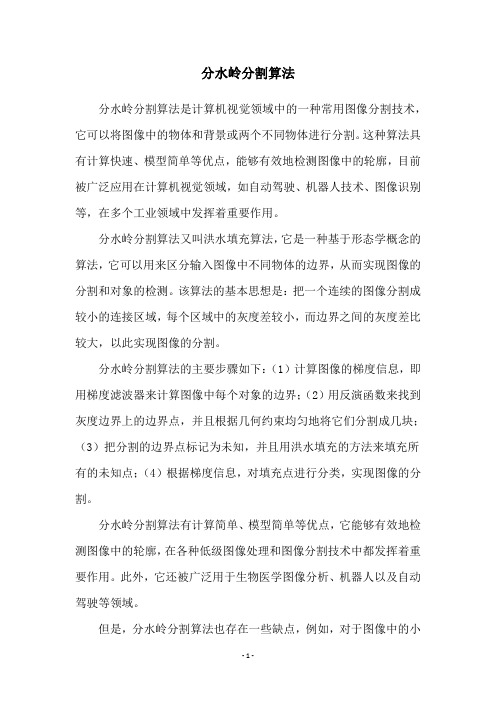
分水岭分割算法分水岭分割算法是计算机视觉领域中的一种常用图像分割技术,它可以将图像中的物体和背景或两个不同物体进行分割。
这种算法具有计算快速、模型简单等优点,能够有效地检测图像中的轮廓,目前被广泛应用在计算机视觉领域,如自动驾驶、机器人技术、图像识别等,在多个工业领域中发挥着重要作用。
分水岭分割算法又叫洪水填充算法,它是一种基于形态学概念的算法,它可以用来区分输入图像中不同物体的边界,从而实现图像的分割和对象的检测。
该算法的基本思想是:把一个连续的图像分割成较小的连接区域,每个区域中的灰度差较小,而边界之间的灰度差比较大,以此实现图像的分割。
分水岭分割算法的主要步骤如下:(1)计算图像的梯度信息,即用梯度滤波器来计算图像中每个对象的边界;(2)用反演函数来找到灰度边界上的边界点,并且根据几何约束均匀地将它们分割成几块;(3)把分割的边界点标记为未知,并且用洪水填充的方法来填充所有的未知点;(4)根据梯度信息,对填充点进行分类,实现图像的分割。
分水岭分割算法有计算简单、模型简单等优点,它能够有效地检测图像中的轮廓,在各种低级图像处理和图像分割技术中都发挥着重要作用。
此外,它还被广泛用于生物医学图像分析、机器人以及自动驾驶等领域。
但是,分水岭分割算法也存在一些缺点,例如,对于图像中的小物体的分割效果较差,容易出现图像分割结果的误分等问题;同时,该算法可能很难处理较大的图像,因为它很容易受到噪声干扰。
因此,在应用分水岭分割算法之前,应该加以考虑,根据不同的场景和要求来选择不同的算法,能够有效地解决图像分割难题。
同时,对算法参数也需要进行调整,以便获得更准确的图像分割结果。
总之,分水岭分割算法是一种简单有效的图像分割技术,它可以用来分割图像中不同物体的边界,广泛应用于计算机视觉领域,为多个工业领域提供了有效的解决方案。
但是,它也存在一些缺点,所以,在使用该算法时,应当仔细考虑,以便获得更好的图像分割结果。
分水岭 算法
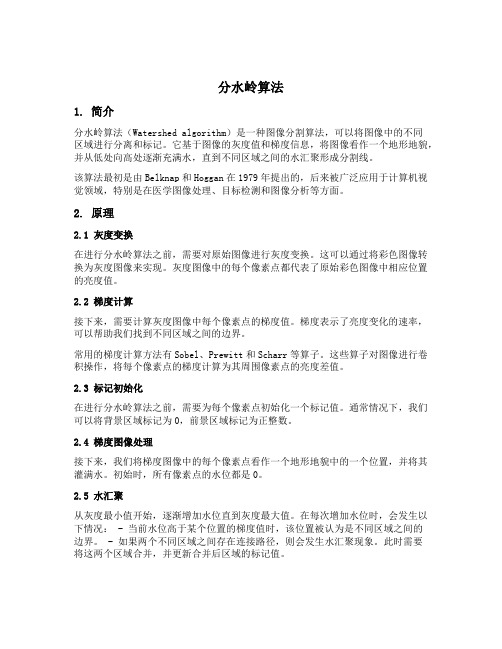
分水岭算法1. 简介分水岭算法(Watershed algorithm)是一种图像分割算法,可以将图像中的不同区域进行分离和标记。
它基于图像的灰度值和梯度信息,将图像看作一个地形地貌,并从低处向高处逐渐充满水,直到不同区域之间的水汇聚形成分割线。
该算法最初是由Belknap和Hoggan在1979年提出的,后来被广泛应用于计算机视觉领域,特别是在医学图像处理、目标检测和图像分析等方面。
2. 原理2.1 灰度变换在进行分水岭算法之前,需要对原始图像进行灰度变换。
这可以通过将彩色图像转换为灰度图像来实现。
灰度图像中的每个像素点都代表了原始彩色图像中相应位置的亮度值。
2.2 梯度计算接下来,需要计算灰度图像中每个像素点的梯度值。
梯度表示了亮度变化的速率,可以帮助我们找到不同区域之间的边界。
常用的梯度计算方法有Sobel、Prewitt和Scharr等算子。
这些算子对图像进行卷积操作,将每个像素点的梯度计算为其周围像素点的亮度差值。
2.3 标记初始化在进行分水岭算法之前,需要为每个像素点初始化一个标记值。
通常情况下,我们可以将背景区域标记为0,前景区域标记为正整数。
2.4 梯度图像处理接下来,我们将梯度图像中的每个像素点看作一个地形地貌中的一个位置,并将其灌满水。
初始时,所有像素点的水位都是0。
2.5 水汇聚从灰度最小值开始,逐渐增加水位直到灰度最大值。
在每次增加水位时,会发生以下情况: - 当前水位高于某个位置的梯度值时,该位置被认为是不同区域之间的边界。
- 如果两个不同区域之间存在连接路径,则会发生水汇聚现象。
此时需要将这两个区域合并,并更新合并后区域的标记值。
2.6 分割结果当水位达到最大值时,分割过程结束。
此时所有不同区域之间都有了明确的边界,并且每个区域都有了唯一的标记值。
3. 算法优缺点3.1 优点•分水岭算法是一种无监督学习方法,不需要依赖任何先验知识或训练数据。
•可以对图像中的任意区域进行分割,不受形状、大小和数量的限制。
图像处理中的标记分水岭分割算法

图像处理中的标记分水岭分割算法如果图像中的目标物体是连接在一起的,则分割起来会更困难,分水岭分割算法经常用于处理这类问题,通常会取得比较好的效果。
分水岭分割算法把图像看成一幅“地形图”,其中亮度比较强的区域像素值较大,而比较暗的区域像素值较小,通过寻找“汇水盆地”和“分水岭界限”,对图像进行分割。
直接应用分水岭分割算法的效果往往并不好,如果在图像中对前景对象和背景对象进行标注区别,再应用分水岭算法会取得较好的分割效果。
有很多图像处理工具箱函数可以用到,如fspecial、imfilter、watershed、lable2rgb、imopen、imclose、imreconstruct、imcomplement、imregionalmax、bwareaopen、graythresh、和imimposemin函数等。
下面进行一个例子,步骤如下。
1、读取图像并求其边界,代码如下。
rgb = imread('');%读取原图像I = rgb2gray(rgb);%转化为灰度图像figure; subplot(121)%显示灰度图像imshow(I)text(732,501,'Image courtesy of Corel',...'FontSize',7,'HorizontalAlignment','right')hy = fspecial('sobel');%sobel算子hx = hy';Iy = imfilter(double(I), hy, 'replicate');%滤波求Y方向边缘Ix = imfilter(double(I), hx, 'replicate');%滤波求X方向边缘gradmag = sqrt(Ix.^2 + Iy.^2);%求模subplot(122); imshow(gradmag,[]), %显示梯度title('Gradient magnitude (gradmag)')在这一步骤中,首先读取一套真彩色图像,然后把真色图像转化为灰度图像,结果如图所示:Gradient magnitude (gradmag)Image courtesy of Corel图1原图和梯度图像使用sobel边缘算子对图像进行水平和垂直方向的滤波,然后求取模值,sobel算子滤波后的图像在边缘处会显示比较大的值,在没有边界处的值会很小,如上图右图所示。
分水岭 算法

分水岭算法1. 介绍分水岭算法(Watershed algorithm)是一种图像处理算法,主要用于图像分割。
它以图像中的亮度或颜色信息为基础,将图像划分为不同的区域,从而实现图像的分割与提取。
分水岭算法的基本原理是将图像视为地形图,其中亮度或颜色信息类似于地形高度,而分水岭则代表不同的区域。
通过模拟水从高处流下,在分水岭相交的地方形成分割线,将图像分成不同的区域。
分水岭算法广泛应用于计算机视觉、图像分析、医学图像处理等领域。
它可以用于目标检测、图像分割、图像融合、边缘检测等任务。
分水岭算法具有较好的鲁棒性和适应性,对于不同类型的图像都能取得较好的效果。
2. 基本原理分水岭算法的基本原理可以概括为以下几个步骤:2.1 灰度化首先,将彩色图像转换为灰度图像。
这是因为分水岭算法主要基于图像的亮度信息进行分割,灰度图像能够更好地表达图像的亮度变化。
2.2 预处理对灰度图像进行预处理,包括去噪和平滑处理。
去噪可以使用各种滤波器,如中值滤波器、高斯滤波器等。
平滑处理可以使用图像平滑算法,如均值滤波器、高斯滤波器等。
预处理的目的是减少图像中的噪声和不必要的细节,使得后续的分割更加准确。
2.3 计算梯度图像通过计算图像的梯度,可以得到图像中的边缘信息。
常用的梯度算子有Sobel算子、Prewitt算子等。
梯度图像可以用来寻找图像中的边缘和区域边界。
2.4 标记种子点选择一些种子点,作为分水岭的起始点。
种子点通常位于图像中的明显边缘或区域边界处。
可以手动选择种子点,也可以使用自动选择的方法。
2.5 填充区域从种子点开始,利用水流模拟的方式填充整个图像。
水从高处向低处流动,当水流到达一个分水岭时,会分流到周围的区域中。
在水流过程中,会形成分割线,将图像分成不同的区域。
2.6 分割结果根据分水岭的位置,将图像分成不同的区域。
分割结果可以通过分水岭线进行可视化展示,也可以将不同区域标记为不同的颜色。
3. 算法改进分水岭算法在实际应用中存在一些问题,如过分细化、过分合并等。
分水岭算法
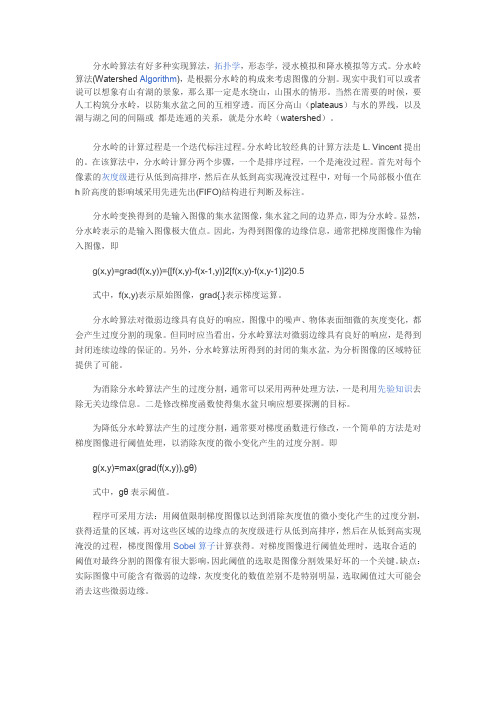
分水岭算法有好多种实现算法,拓扑学,形态学,浸水模拟和降水模拟等方式。
分水岭算法(Watershed Algorithm),是根据分水岭的构成来考虑图像的分割。
现实中我们可以或者说可以想象有山有湖的景象,那么那一定是水绕山,山围水的情形。
当然在需要的时候,要人工构筑分水岭,以防集水盆之间的互相穿透。
而区分高山(plateaus)与水的界线,以及湖与湖之间的间隔或都是连通的关系,就是分水岭(watershed)。
分水岭的计算过程是一个迭代标注过程。
分水岭比较经典的计算方法是L. Vincent提出的。
在该算法中,分水岭计算分两个步骤,一个是排序过程,一个是淹没过程。
首先对每个像素的灰度级进行从低到高排序,然后在从低到高实现淹没过程中,对每一个局部极小值在h阶高度的影响域采用先进先出(FIFO)结构进行判断及标注。
分水岭变换得到的是输入图像的集水盆图像,集水盆之间的边界点,即为分水岭。
显然,分水岭表示的是输入图像极大值点。
因此,为得到图像的边缘信息,通常把梯度图像作为输入图像,即g(x,y)=grad(f(x,y))={[f(x,y)-f(x-1,y)]2[f(x,y)-f(x,y-1)]2}0.5式中,f(x,y)表示原始图像,grad{.}表示梯度运算。
分水岭算法对微弱边缘具有良好的响应,图像中的噪声、物体表面细微的灰度变化,都会产生过度分割的现象。
但同时应当看出,分水岭算法对微弱边缘具有良好的响应,是得到封闭连续边缘的保证的。
另外,分水岭算法所得到的封闭的集水盆,为分析图像的区域特征提供了可能。
为消除分水岭算法产生的过度分割,通常可以采用两种处理方法,一是利用先验知识去除无关边缘信息。
二是修改梯度函数使得集水盆只响应想要探测的目标。
为降低分水岭算法产生的过度分割,通常要对梯度函数进行修改,一个简单的方法是对梯度图像进行阈值处理,以消除灰度的微小变化产生的过度分割。
即g(x,y)=max(grad(f(x,y)),gθ)式中,gθ表示阈值。
分水岭算法

分水岭算法的概念及原理分水岭分割方法,是一种基于拓扑理论的数学形态学的分割方法,其基本思想是把图像看作是测地学上的拓扑地貌,图像中每一点像素的灰度值表示该点的海拔高度,每一个局部极小值及其影响区域称为集水盆,而集水盆的边界则形成分水岭。
分水岭的概念和形成可以通过模拟浸入过程来说明。
在每一个局部极小值表面,刺穿一个小孔,然后把整个模型慢慢浸入水中,随着浸入的加深,每一个局部极小值的影响域慢慢向外扩展,在两个集水盆汇合处构筑大坝,即形成分水岭。
分水岭的计算过程是一个迭代标注过程。
分水岭比较经典的计算方法是L. Vincent提出的。
在该算法中,分水岭计算分两个步骤,一个是排序过程,一个是淹没过程。
首先对每个像素的灰度级进行从低到高排序,然后在从低到高实现淹没过程中,对每一个局部极小值在h阶高度的影响域采用先进先出(FIFO)结构进行判断及标注。
分水岭变换得到的是输入图像的集水盆图像,集水盆之间的边界点,即为分水岭。
显然,分水岭表示的是输入图像极大值点。
因此,为得到图像的边缘信息,通常把梯度图像作为输入图像,即g(x,y)=grad(f(x,y))={[f(x,y)-f(x-1,y)]2[f(x,y)-f(x,y-1)]2}0.5式中,f(x,y)表示原始图像,grad{.}表示梯度运算。
分水岭算法对微弱边缘具有良好的响应,图像中的噪声、物体表面细微的灰度变化,都会产生过度分割的现象。
但同时应当看出,分水岭算法对微弱边缘具有良好的响应,是得到封闭连续边缘的保证的。
另外,分水岭算法所得到的封闭的集水盆,为分析图像的区域特征提供了可能。
为消除分水岭算法产生的过度分割,通常可以采用两种处理方法,一是利用先验知识去除无关边缘信息。
二是修改梯度函数使得集水盆只响应想要探测的目标。
为降低分水岭算法产生的过度分割,通常要对梯度函数进行修改,一个简单的方法是对梯度图像进行阈值处理,以消除灰度的微小变化产生的过度分割。
分水岭算法
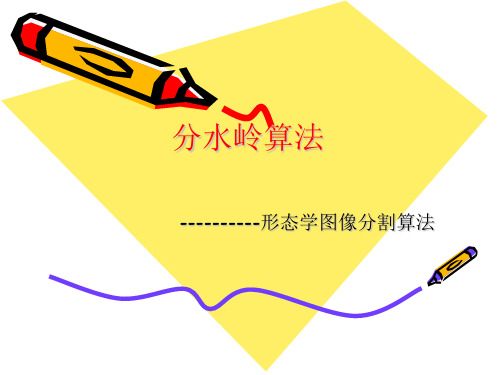
分水岭算法
定义变量(续)
表 示 位 于 平 面 g ( x , y ) = n 下 方 的 点 的 集 合
表 示 第 n 阶 段 汇 水 盆 地 i 中 点 的 集 合
表 示 第 n 阶 段 汇 水 盆 地 被 水 淹 没 部 分 的 集 合
所 有 汇 水 盆 地 的 集 合
初始化: C [ m in 1 ] T [ m in 1 ]
终止:n=max+1
分水岭分割方法应用在图像的梯度,那么集水处在理论上 就对应灰度变化最小的区域,而分水岭就对应灰度变化相 对最大的区域.
从上到下,从右到左
•原始图 •梯度图 •梯度图的分水岭 •最终轮廓
缺点:由于噪声或者局部不规则而引起”过度分割”
电泳凝胶图像与经过分水岭转变的分割图
分水岭算法的改进
递归: 根 据 C [n 1 ] 求 得 C [n ]
递归(续)
遇 到 新 的 最 小 值 时 ,符 合 条 件 (a),将 q并 入 C[n1]构 成 C[n]; q位 于 某 些 局 部 最 小 值 构 成 的 汇 水 盆 地 时 ,符 合 条 件 (b),将 q并 入 C[n1]构 成 C[n];当 遇 到 分 离 全 部 或 部 分 汇 水 盆 地 时 , 符 合 条 件 (c),在 q建 水 坝 .
分割原理
(1)任何的灰度级图像都可以被看做是一个地形图
(2)假设我们在每个区域最小值位置地方打个洞,让水以 均匀的速度上升,从低到高淹没整个地形.当处在不同的 汇聚盆地中的水将要聚合在一起时,修建大坝将阻止聚 合,最后得到的水坝边界就是分水岭的分割线.
定义变量
分水岭算法
C ( M i ) 表 示 与 局 部 最 小 值 M i 相 联 系 的 汇 水 盆 地 内 点 的 集 合
分水岭算法

分水岭算法1. 简介分水岭算法是一种用于图像分割的算法。
通过将图像视为地形地貌,将图像中的每个像素视为一个水滴,从低处开始模拟水的渗透和汇聚过程,最终得到图像中的不同区域。
分水岭算法最初用于地理学中的水文地貌研究,后来被引入到计算机视觉领域中。
它在图像分割、目标检测、图像处理等方面具有广泛的应用。
2. 算法步骤分水岭算法包含以下几个步骤:2.1 图像预处理首先,对原始图像进行预处理,以便更好地进行分水岭算法的运算。
预处理的步骤可以包括灰度化、去噪、平滑滤波等。
2.2 计算图像的梯度梯度表示图像中每个像素的边缘强度。
通过计算图像的梯度,可以找到图像中的边缘和纹理信息。
常用的计算梯度的方法包括Sobel、Prewitt等算子。
2.3 寻找图像中的标记点标记点是分水岭算法中的关键概念,表示图像中的起始点或分水岭点。
标记点的选取对于最终分割结果有很大的影响。
通常情况下,可以通过阈值分割、连通区域分析等方法寻找图像中的标记点。
2.4 计算距离变换图距离变换图是一个将图像中每个像素替换为其与最近标记点之间距离的图像。
通过计算距离变换图,可以评估每个像素到最近标记点的距离。
2.5 计算分水岭线分水岭线是指图像中的边缘或过渡区域,它将不同的区域分隔开来。
通过计算距离变换图,可以找到图像中的分水岭线。
2.6 执行分水岭漫水算法最后,执行分水岭漫水算法,将图像中的每个像素与标记点进行比较,并根据像素值和距离变换图进行分割。
分水岭漫水算法会将图像中的不同区域分割成若干个连通区域。
3. 算法优缺点3.1 优点•分水岭算法可以对图像进行多种类型的分割,包括分割不完全的区域和不规则形状的目标。
•分水岭算法不需要预先知道目标的数量。
•分水岭算法可以自动识别图像中的背景和前景。
3.2 缺点•分水岭算法对于噪声和纹理较强的图像分割效果不理想。
•分水岭算法对于图像中的非连通区域分割效果差。
•分水岭算法具有较高的计算复杂度,对于大规模图像处理较为困难。
分水岭分割方法
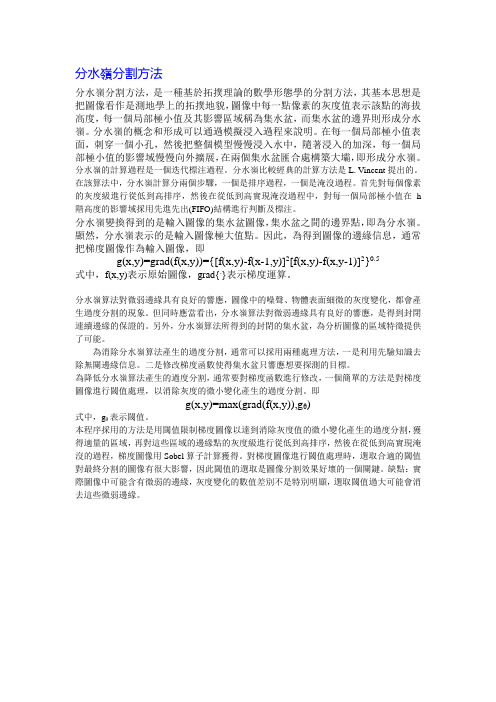
分水嶺分割方法分水嶺分割方法,是一種基於拓撲理論的數學形態學的分割方法,其基本思想是把圖像看作是測地學上的拓撲地貌,圖像中每一點像素的灰度值表示該點的海拔高度,每一個局部極小值及其影響區域稱為集水盆,而集水盆的邊界則形成分水嶺。
分水嶺的概念和形成可以通過模擬浸入過程來說明。
在每一個局部極小值表面,刺穿一個小孔,然後把整個模型慢慢浸入水中,隨著浸入的加深,每一個局部極小值的影響域慢慢向外擴展,在兩個集水盆匯合處構築大壩,即形成分水嶺。
分水嶺的計算過程是一個迭代標注過程。
分水嶺比較經典的計算方法是L. Vincent提出的。
在該算法中,分水嶺計算分兩個步驟,一個是排序過程,一個是淹沒過程。
首先對每個像素的灰度級進行從低到高排序,然後在從低到高實現淹沒過程中,對每一個局部極小值在h 階高度的影響域採用先進先出(FIFO)結構進行判斷及標注。
分水嶺變換得到的是輸入圖像的集水盆圖像,集水盆之間的邊界點,即為分水嶺。
顯然,分水嶺表示的是輸入圖像極大值點。
因此,為得到圖像的邊緣信息,通常把梯度圖像作為輸入圖像,即g(x,y)=grad(f(x,y))={[f(x,y)-f(x-1,y)]2[f(x,y)-f(x,y-1)]2}0.5式中,f(x,y)表示原始圖像,grad{.}表示梯度運算。
分水嶺算法對微弱邊緣具有良好的響應,圖像中的噪聲、物體表面細微的灰度變化,都會產生過度分割的現象。
但同時應當看出,分水嶺算法對微弱邊緣具有良好的響應,是得到封閉連續邊緣的保證的。
另外,分水嶺算法所得到的封閉的集水盆,為分析圖像的區域特徵提供了可能。
為消除分水嶺算法產生的過度分割,通常可以採用兩種處理方法,一是利用先驗知識去除無關邊緣信息。
二是修改梯度函數使得集水盆只響應想要探測的目標。
為降低分水嶺算法產生的過度分割,通常要對梯度函數進行修改,一個簡單的方法是對梯度圖像進行閾值處理,以消除灰度的微小變化產生的過度分割。
即g(x,y)=max(grad(f(x,y)),gθ)式中,gθ表示閾值。
分水岭分割——精选推荐

分⽔岭分割分⽔岭分割利⽤图像形态学进⾏图像区域分割。
它将图像灰度值看作⼀幅地形图,在地形图的局部极⼩值处与地形最低点是连通的,从最低点开始注⽔,⽔流会逐渐淹没地形较低点构成的区域,直到整个图像被淹没。
在这个过程中,通过相关形态学处理,可以实现⼀幅图像的分⽔岭分割。
以下GIF图像给出了形象说明:分⽔岭分割具体算法思想如下:1 设为地形图上完成分割后的 r 个蓄⽔池,为完成分割后蓄⽔池内的像数集合,为地形图上灰度值⼩于 n 的像数集合;2 当⽔⾯上涨到 n 时,当前蓄⽔池被淹没的像数集合可表⽰为:,当前所有蓄⽔池被淹没的像数集合表⽰为:;3 假设第 n 步时,已知,令 Q 表⽰集合构成的连通区域,通过考察 Q 上各个连通区域 q 与连通区域关系,分别进⾏如下处理:1)为空时,发现⼀个新的蓄⽔池 q,将 q 加⼊;2)不为空,但仅包含的⼀个连通分量,将 q 合并到中构成,蓄⽔池⾯积扩⼤,但数量保持不变;3)不为空,但包含的两个及两个以上连通分量,此时需要构造堤坝防⽌中蓄⽔池融合;4 重复步骤3,直到 n = nmax + 1 时,表⽰整个图像像数,分割完成,各个连通区域即为分割的蓄⽔池区域,留下的堤坝则为分割边界。
以上为分⽔岭分割基本思想,图像的每个极⼩值点构成⼀个蓄⽔池的中⼼点。
由于图像中存在较多极⼩值点,故⼀般图像分⽔岭分割可能得到很多⼩的区域。
可以通过⼿动设定蓄⽔池位置来避免过多极⼩值影响,算法仅认为设定点为蓄⽔池中⼼点,从⽽忽略掉任意其他极⼩值点。
同时,可以⾸先对图像进⾏⼀阶微分处理,在图像平滑区域图像梯度值较⼩,在图像边缘区域梯度值较⼤。
然后使⽤梯度图像作为地形图,可以分割出平滑图像块。
在 opencv 中,函数 cv::watershed() 实现了分⽔岭分割,该函数将图像边缘转换为地形图上的⼭脊,图像平滑区域转换为地形图上的⼭⾕,同时使⽤ markers 参数标记蓄⽔池,实现分⽔岭分割,具体如下:void cv::watershed(cv::InputArray image, cv::InputOutputArray markers);image: 8位3通道图像,函数对图像进⾏⼀阶微分处理,视梯度图为地形图上的⼭脊与⼭⾕;markers: 32位有符号整数图像,使⽤ 1,2,3... 等序号标记不同的蓄⽔池。
分水岭算法综述

分水岭算法综述分水岭算法是图像分割领域中常用的一种算法,它可以将图像分割成不同的区域,每个区域内的像素具有相似的特征。
本文将对分水岭算法进行综述,介绍其原理、应用以及优缺点。
一、分水岭算法的原理分水岭算法的原理源于水在山谷中流动的过程。
首先,将图像看作一个地形图,较亮的区域对应山峰,较暗的区域对应山谷。
然后,通过在地形图上进行洪水填充,使得水从山峰的高处流向山谷的低处,最终形成水汇聚的区域。
这些水汇聚的区域即为图像的分割结果。
分水岭算法的核心是确定图像中的山峰和山谷。
为了实现这一点,需要进行图像的预处理。
首先,对图像进行灰度化处理,将彩色图像转换为灰度图像。
然后,通过应用梯度算子,计算图像中每个像素的梯度值。
梯度值较大的像素被认为是山峰,梯度值较小的像素被认为是山谷。
在预处理完成后,可以开始进行分水岭算法的主要步骤。
首先,将山峰像素标记为前景,山谷像素标记为背景。
然后,将标记的像素区域称为markers。
接下来,通过对markers进行洪水填充,将水从山峰处逐渐流向山谷。
当水汇聚到一定程度时,会形成分割的边界,即分水岭。
二、分水岭算法的应用分水岭算法在图像分割领域有广泛的应用。
以下是一些常见的应用场景:1. 医学图像分割:分水岭算法可以用于医学图像的分割,如MRI图像中的肿瘤分割、X射线图像中的骨骼分割等。
通过将图像分割成不同的区域,医生可以更好地观察和分析病变部位。
2. 地质勘探:分水岭算法可以用于地质勘探中的岩石分割。
通过将地质图像分割成不同的区域,可以更好地识别和分析不同类型的岩石,有助于矿产资源的开发和利用。
3. 视觉检测:分水岭算法可以用于视觉检测中的目标分割。
通过将图像中的目标分割出来,可以更好地进行目标识别和跟踪,有助于自动驾驶、智能监控等领域的发展。
三、分水岭算法的优缺点分水岭算法具有以下优点:1. 算法简单:分水岭算法的原理简单易懂,实现相对容易。
2. 适用性广泛:分水岭算法可以用于不同类型的图像,包括医学图像、地质图像、自然图像等。
分水岭分割算法
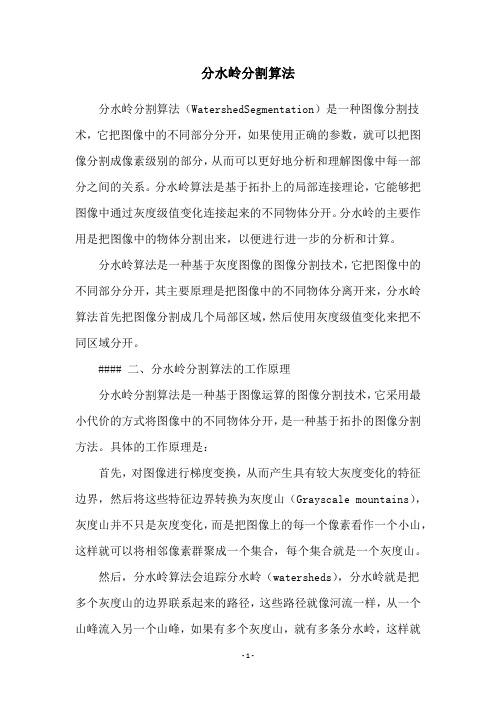
分水岭分割算法分水岭分割算法(WatershedSegmentation)是一种图像分割技术,它把图像中的不同部分分开,如果使用正确的参数,就可以把图像分割成像素级别的部分,从而可以更好地分析和理解图像中每一部分之间的关系。
分水岭算法是基于拓扑上的局部连接理论,它能够把图像中通过灰度级值变化连接起来的不同物体分开。
分水岭的主要作用是把图像中的物体分割出来,以便进行进一步的分析和计算。
分水岭算法是一种基于灰度图像的图像分割技术,它把图像中的不同部分分开,其主要原理是把图像中的不同物体分离开来,分水岭算法首先把图像分割成几个局部区域,然后使用灰度级值变化来把不同区域分开。
#### 二、分水岭分割算法的工作原理分水岭分割算法是一种基于图像运算的图像分割技术,它采用最小代价的方式将图像中的不同物体分开,是一种基于拓扑的图像分割方法。
具体的工作原理是:首先,对图像进行梯度变换,从而产生具有较大灰度变化的特征边界,然后将这些特征边界转换为灰度山(Grayscale mountains),灰度山并不只是灰度变化,而是把图像上的每一个像素看作一个小山,这样就可以将相邻像素群聚成一个集合,每个集合就是一个灰度山。
然后,分水岭算法会追踪分水岭(watersheds),分水岭就是把多个灰度山的边界联系起来的路径,这些路径就像河流一样,从一个山峰流入另一个山峰,如果有多个灰度山,就有多条分水岭,这样就可以把图像中的不同物体分隔开来。
最后,通过对每条分水岭的分析,就可以把图像中的不同物体分开,达到图像分割的目的。
#### 三、分水岭分割算法的优点分水岭分割算法是一种图像分割技术,它可以把图像分割成几个局部区域,然后使用灰度级值变化来把不同区域分开,从而把图像中的不同物体分离开来。
分水岭分割算法有以下优点:(1)计算简单:分水岭分割算法的计算是基于拓扑的局部连接理论,而不是复杂的理论,因此它的运算速度快,计算量少,是一种高效的图像分割技术。
分水岭分割算法及其基本步骤
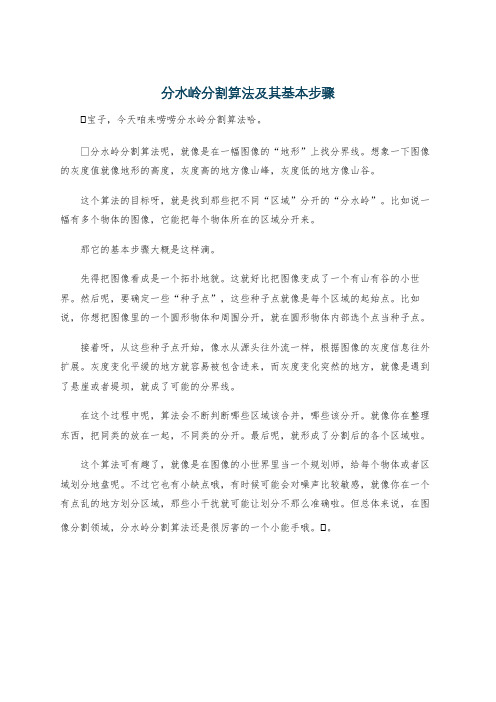
分水岭分割算法及其基本步骤
宝子,今天咱来唠唠分水岭分割算法哈。
分水岭分割算法呢,就像是在一幅图像的“地形”上找分界线。
想象一下图像的灰度值就像地形的高度,灰度高的地方像山峰,灰度低的地方像山谷。
这个算法的目标呀,就是找到那些把不同“区域”分开的“分水岭”。
比如说一幅有多个物体的图像,它能把每个物体所在的区域分开来。
那它的基本步骤大概是这样滴。
先得把图像看成是一个拓扑地貌。
这就好比把图像变成了一个有山有谷的小世界。
然后呢,要确定一些“种子点”,这些种子点就像是每个区域的起始点。
比如说,你想把图像里的一个圆形物体和周围分开,就在圆形物体内部选个点当种子点。
接着呀,从这些种子点开始,像水从源头往外流一样,根据图像的灰度信息往外扩展。
灰度变化平缓的地方就容易被包含进来,而灰度变化突然的地方,就像是遇到了悬崖或者堤坝,就成了可能的分界线。
在这个过程中呢,算法会不断判断哪些区域该合并,哪些该分开。
就像你在整理东西,把同类的放在一起,不同类的分开。
最后呢,就形成了分割后的各个区域啦。
这个算法可有趣了,就像是在图像的小世界里当一个规划师,给每个物体或者区域划分地盘呢。
不过它也有小缺点哦,有时候可能会对噪声比较敏感,就像你在一个有点乱的地方划分区域,那些小干扰就可能让划分不那么准确啦。
但总体来说,在图像分割领域,分水岭分割算法还是很厉害的一个小能手哦。
。
分水岭算法详细介绍与应用
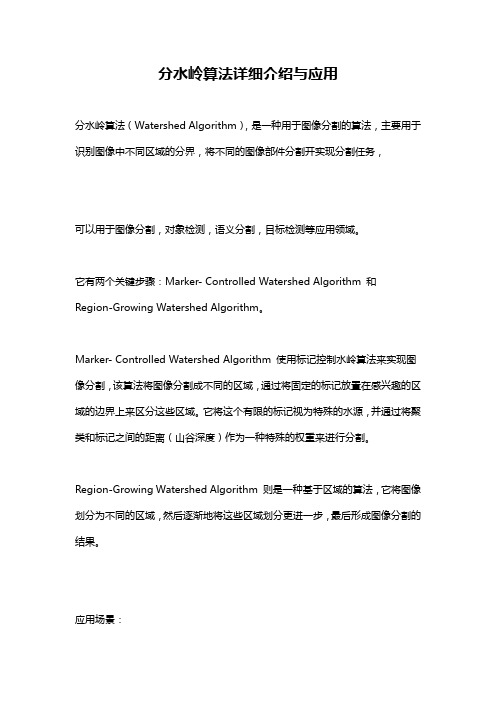
分水岭算法详细介绍与应用
分水岭算法(Watershed Algorithm),是一种用于图像分割的算法,主要用于识别图像中不同区域的分界,将不同的图像部件分割开实现分割任务,
可以用于图像分割,对象检测,语义分割,目标检测等应用领域。
它有两个关键步骤:Marker- Controlled Watershed Algorithm 和Region-Growing Watershed Algorithm。
Marker- Controlled Watershed Algorithm 使用标记控制水岭算法来实现图像分割,该算法将图像分割成不同的区域,通过将固定的标记放置在感兴趣的区域的边界上来区分这些区域。
它将这个有限的标记视为特殊的水源,并通过将聚类和标记之间的距离(山谷深度)作为一种特殊的权重来进行分割。
Region-Growing Watershed Algorithm 则是一种基于区域的算法,它将图像划分为不同的区域,然后逐渐地将这些区域划分更进一步,最后形成图像分割的结果。
应用场景:
1. 医学图像分割:分水岭算法可用于分割脑部及胸部CT图像,识别出特定部位,可用于肿瘤信息检测等;
2. 目标检测:分水岭算法可用于目标行为分析中,识别出舞蹈等动作;
3. 车牌识别:分水岭算法可与边缘检测相结合,实现车牌的识别;
4. 美容整形:使用分水岭算法用于晶体管(LightSheet)成像中,可以更精确的识别出需要整形的面部特征,比如眼睛、口红、嘴唇等;
5. 地图编辑:使用分水岭算法可以帮助专业人员编辑某个地点的街道图,例如,可以将街道、公园、河流等分割出来;
6. 后期处理:可以用分水岭算法来帮助专业人员识别难以被分辨的图像,如细胞等。
分水岭算法解析
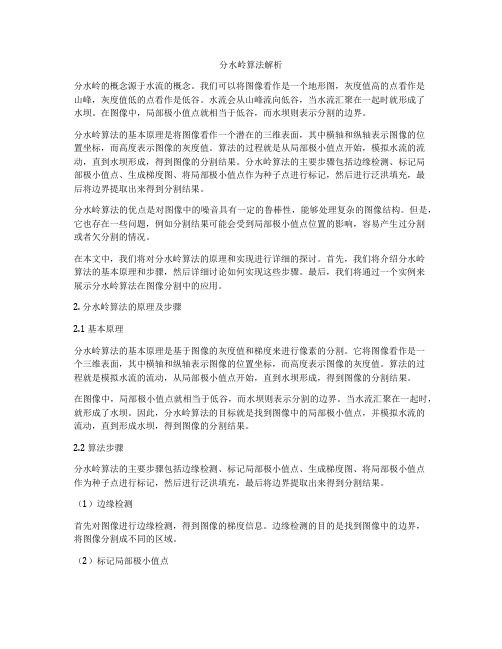
分水岭算法解析分水岭的概念源于水流的概念。
我们可以将图像看作是一个地形图,灰度值高的点看作是山峰,灰度值低的点看作是低谷。
水流会从山峰流向低谷,当水流汇聚在一起时就形成了水坝。
在图像中,局部极小值点就相当于低谷,而水坝则表示分割的边界。
分水岭算法的基本原理是将图像看作一个潜在的三维表面,其中横轴和纵轴表示图像的位置坐标,而高度表示图像的灰度值。
算法的过程就是从局部极小值点开始,模拟水流的流动,直到水坝形成,得到图像的分割结果。
分水岭算法的主要步骤包括边缘检测、标记局部极小值点、生成梯度图、将局部极小值点作为种子点进行标记,然后进行泛洪填充,最后将边界提取出来得到分割结果。
分水岭算法的优点是对图像中的噪音具有一定的鲁棒性,能够处理复杂的图像结构。
但是,它也存在一些问题,例如分割结果可能会受到局部极小值点位置的影响,容易产生过分割或者欠分割的情况。
在本文中,我们将对分水岭算法的原理和实现进行详细的探讨。
首先,我们将介绍分水岭算法的基本原理和步骤,然后详细讨论如何实现这些步骤。
最后,我们将通过一个实例来展示分水岭算法在图像分割中的应用。
2. 分水岭算法的原理及步骤2.1 基本原理分水岭算法的基本原理是基于图像的灰度值和梯度来进行像素的分割。
它将图像看作是一个三维表面,其中横轴和纵轴表示图像的位置坐标,而高度表示图像的灰度值。
算法的过程就是模拟水流的流动,从局部极小值点开始,直到水坝形成,得到图像的分割结果。
在图像中,局部极小值点就相当于低谷,而水坝则表示分割的边界。
当水流汇聚在一起时,就形成了水坝。
因此,分水岭算法的目标就是找到图像中的局部极小值点,并模拟水流的流动,直到形成水坝,得到图像的分割结果。
2.2 算法步骤分水岭算法的主要步骤包括边缘检测、标记局部极小值点、生成梯度图、将局部极小值点作为种子点进行标记,然后进行泛洪填充,最后将边界提取出来得到分割结果。
(1)边缘检测首先对图像进行边缘检测,得到图像的梯度信息。
基于形态学分水岭的分割
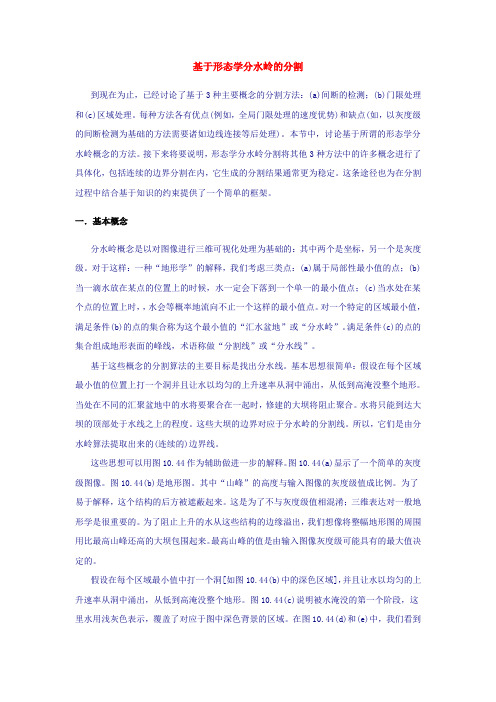
基于形态学分水岭的分割到现在为止,已经讨论了基于3种主要概念的分割方法:(a)间断的检测;(b)门限处理和(c)区域处理。
每种方法各有优点(例如,全局门限处理的速度优势)和缺点(如,以灰度级的间断检测为基础的方法需要诸如边线连接等后处理)。
本节中,讨论基于所谓的形态学分水岭概念的方法。
接下来将要说明,形态学分水岭分割将其他3种方法中的许多概念进行了具体化,包括连续的边界分割在内,它生成的分割结果通常更为稳定。
这条途径也为在分割过程中结合基于知识的约束提供了一个简单的框架。
一.基本概念分水岭概念是以对图像进行三维可视化处理为基础的:其中两个是坐标,另一个是灰度级。
对于这样:一种“地形学”的解释,我们考虑三类点:(a)属于局部性最小值的点;(b)当一滴水放在某点的位置上的时候,水一定会下落到一个单一的最小值点;(c)当水处在某个点的位置上时,,水会等概率地流向不止一个这样的最小值点。
对一个特定的区域最小值,满足条件(b)的点的集合称为这个最小值的“汇水盆地”或“分水岭”。
满足条件(c)的点的集合组成地形表面的峰线,术语称做“分割线”或“分水线”。
基于这些概念的分割算法的主要目标是找出分水线。
基本思想很简单:假设在每个区域最小值的位置上打一个洞并且让水以均匀的上升速率从洞中涌出,从低到高淹没整个地形。
当处在不同的汇聚盆地中的水将要聚合在一起时,修建的大坝将阻止聚合。
水将只能到达大坝的顶部处于水线之上的程度。
这些大坝的边界对应于分水岭的分割线。
所以,它们是由分水岭算法提取出来的(连续的)边界线。
这些思想可以用图10.44作为辅助做进一步的解释。
图10.44(a)显示了一个简单的灰度级图像。
图10.44(b)是地形图。
其中“山峰”的高度与输入图像的灰度级值成比例。
为了易于解释,这个结构的后方被遮蔽起来。
这是为了不与灰度级值相混淆;三维表达对一般地形学是很重要的。
为了阻止上升的水从这些结构的边缘溢出,我们想像将整幅地形图的周围用比最高山峰还高的大坝包围起来。
分水岭算法解析
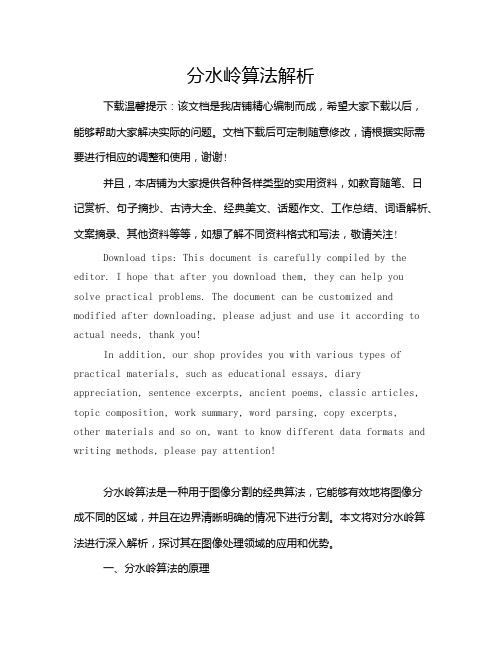
分水岭算法解析下载温馨提示:该文档是我店铺精心编制而成,希望大家下载以后,能够帮助大家解决实际的问题。
文档下载后可定制随意修改,请根据实际需要进行相应的调整和使用,谢谢!并且,本店铺为大家提供各种各样类型的实用资料,如教育随笔、日记赏析、句子摘抄、古诗大全、经典美文、话题作文、工作总结、词语解析、文案摘录、其他资料等等,如想了解不同资料格式和写法,敬请关注!Download tips: This document is carefully compiled by the editor. I hope that after you download them, they can help yousolve practical problems. The document can be customized and modified after downloading, please adjust and use it according to actual needs, thank you!In addition, our shop provides you with various types of practical materials, such as educational essays, diary appreciation, sentence excerpts, ancient poems, classic articles, topic composition, work summary, word parsing, copy excerpts,other materials and so on, want to know different data formats and writing methods, please pay attention!分水岭算法是一种用于图像分割的经典算法,它能够有效地将图像分成不同的区域,并且在边界清晰明确的情况下进行分割。
分水岭算法
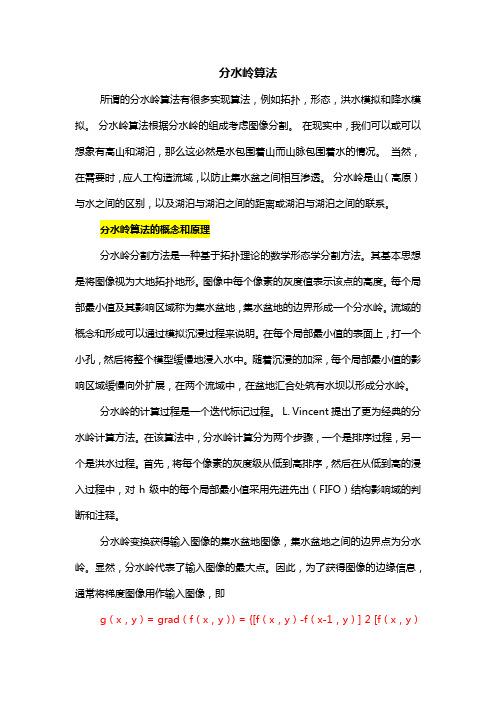
分水岭算法所谓的分水岭算法有很多实现算法,例如拓扑,形态,洪水模拟和降水模拟。
分水岭算法根据分水岭的组成考虑图像分割。
在现实中,我们可以或可以想象有高山和湖泊,那么这必然是水包围着山而山脉包围着水的情况。
当然,在需要时,应人工构造流域,以防止集水盆之间相互渗透。
分水岭是山(高原)与水之间的区别,以及湖泊与湖泊之间的距离或湖泊与湖泊之间的联系。
分水岭算法的概念和原理分水岭分割方法是一种基于拓扑理论的数学形态学分割方法。
其基本思想是将图像视为大地拓扑地形。
图像中每个像素的灰度值表示该点的高度。
每个局部最小值及其影响区域称为集水盆地,集水盆地的边界形成一个分水岭。
流域的概念和形成可以通过模拟沉浸过程来说明。
在每个局部最小值的表面上,打一个小孔,然后将整个模型缓慢地浸入水中。
随着沉浸的加深,每个局部最小值的影响区域缓慢向外扩展,在两个流域中,在盆地汇合处筑有水坝以形成分水岭。
分水岭的计算过程是一个迭代标记过程。
L. Vincent提出了更为经典的分水岭计算方法。
在该算法中,分水岭计算分为两个步骤,一个是排序过程,另一个是洪水过程。
首先,将每个像素的灰度级从低到高排序,然后在从低到高的浸入过程中,对h级中的每个局部最小值采用先进先出(FIFO)结构影响域的判断和注释。
分水岭变换获得输入图像的集水盆地图像,集水盆地之间的边界点为分水岭。
显然,分水岭代表了输入图像的最大点。
因此,为了获得图像的边缘信息,通常将梯度图像用作输入图像,即g(x,y)= grad(f(x,y))= {[f(x,y)-f(x-1,y)] 2 [f(x,y)-f(x,y- 1)] 2} 0.5在公式中,f(x,y)代表原始图像,而grad {。
}代表梯度运算。
分水岭算法对弱边缘具有良好的响应。
图像中的噪点和物体表面的细微灰色变化会导致过度分割。
但是同时,应该看到分水岭算法对弱边缘具有良好的响应,并保证获得闭合的连续边缘。
此外,通过分水岭算法获得的封闭收集盆地为分析图像的区域特征提供了可能性。
分水岭分割法
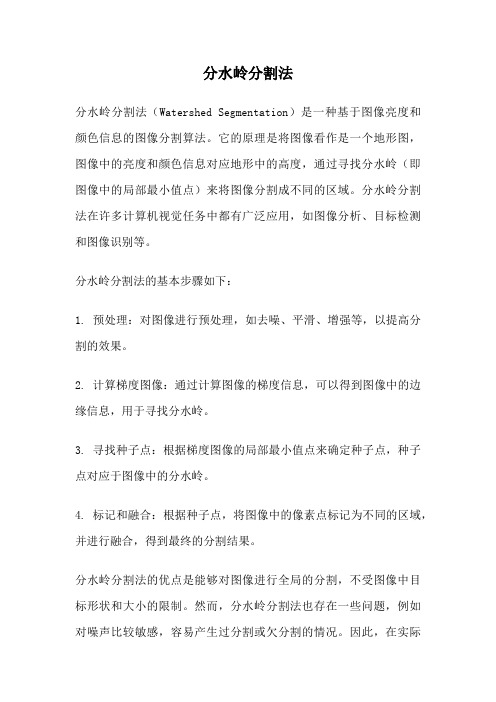
分水岭分割法分水岭分割法(Watershed Segmentation)是一种基于图像亮度和颜色信息的图像分割算法。
它的原理是将图像看作是一个地形图,图像中的亮度和颜色信息对应地形中的高度,通过寻找分水岭(即图像中的局部最小值点)来将图像分割成不同的区域。
分水岭分割法在许多计算机视觉任务中都有广泛应用,如图像分析、目标检测和图像识别等。
分水岭分割法的基本步骤如下:1. 预处理:对图像进行预处理,如去噪、平滑、增强等,以提高分割的效果。
2. 计算梯度图像:通过计算图像的梯度信息,可以得到图像中的边缘信息,用于寻找分水岭。
3. 寻找种子点:根据梯度图像的局部最小值点来确定种子点,种子点对应于图像中的分水岭。
4. 标记和融合:根据种子点,将图像中的像素点标记为不同的区域,并进行融合,得到最终的分割结果。
分水岭分割法的优点是能够对图像进行全局的分割,不受图像中目标形状和大小的限制。
然而,分水岭分割法也存在一些问题,例如对噪声比较敏感,容易产生过分割或欠分割的情况。
因此,在实际应用中,需要根据具体的任务和图像特点选择合适的参数和方法来改进分割效果。
分水岭分割法的应用非常广泛。
在医学图像处理中,可以用于分割病变区域、提取器官结构等。
在遥感图像处理中,可以用于分割地物、提取道路网络等。
在计算机视觉中,可以用于目标检测、图像识别、图像分析等。
此外,分水岭分割法还可以与其他图像处理方法相结合,如边缘检测、阈值分割等,以提高分割效果。
总结起来,分水岭分割法是一种基于图像亮度和颜色信息的图像分割算法,通过寻找分水岭将图像分割成不同的区域。
它在许多计算机视觉任务中都有广泛应用,具有全局分割的优点。
然而,分水岭分割法也存在一些问题,需要根据具体的任务和图像特点来选择合适的方法和参数。
分水岭分割法的应用非常广泛,可以用于医学图像处理、遥感图像处理和计算机视觉等领域。
通过合理地使用分水岭分割法,可以提高图像分割的效果,为后续的图像分析和处理任务提供有力支持。
- 1、下载文档前请自行甄别文档内容的完整性,平台不提供额外的编辑、内容补充、找答案等附加服务。
- 2、"仅部分预览"的文档,不可在线预览部分如存在完整性等问题,可反馈申请退款(可完整预览的文档不适用该条件!)。
- 3、如文档侵犯您的权益,请联系客服反馈,我们会尽快为您处理(人工客服工作时间:9:00-18:30)。
程序代码:(代码标记[code]...[/code] )
clear,clc
%三种方法进行分水岭分割
%读入图像
filename='Fig1021(a)(small-blobs).tif';
f=imread(filename);
Info=imfinfo(filename);
if Info.BitDepth>8
f=rgb2gray(f);
end
figure,mesh(double(f));%显示图像,类似集水盆地
%方法1:一般分水岭分割,从结果可以看出存在过分割问题
b=im2bw(f,graythresh(f));%二值化,注意应保证集水盆地的值较低(为0),否则就要对b取反
d=bwdist(b); %求零值到最近非零值的距离,即集水盆地到分水岭的距离
l=watershed(-d); %matlab自带分水岭算法,l中的零值即为风水岭
w=l==0; %取出边缘
g=b&~w; %用w作为mask从二值图像中取值
figure
subplot(2,3,1),imshow(f);
subplot(2,3,2),imshow(b);
subplot(2,3,3),imshow(d);
subplot(2,3,4),imshow(l);
subplot(2,3,5),imshow(w);
subplot(2,3,6),imshow(g);
%方法2:使用梯度的两次分水岭分割,从结果可以看出还存在过分割问题(在方法1的基础上改进)h=fspecial('sobel');%获得纵方向的sobel算子
fd=double(f);
g=sqrt(imfilter(fd,h,'replicate').^2+imfilter(fd,h','replicate').^2);%使用sobel算子进行梯度运算
l=watershed(g);%分水岭运算
wr=l==0;
g2=imclose(imopen(g,ones(3,3)),ones(3,3));%进行开闭运算对图像进行平滑
l2=watershed(g2);%再次进行分水岭运算
wr2=l2==0;
f2=f;
f2(wr2)=255;
figure
subplot(2,3,1),imshow(f);
subplot(2,3,2),imshow(g);
subplot(2,3,3),imshow(l);
subplot(2,3,4),imshow(g2);
subplot(2,3,5),imshow(l2);
subplot(2,3,6),imshow(f2);
%方法3:使用梯度加掩模的三次分水岭算法(在方法2的基础上改进)
h=fspecial('sobel');%获得纵方向的sobel算子
fd=double(f);
g=sqrt(imfilter(fd,h,'replicate').^2+imfilter(fd,h','replicate').^2);%使用sobel算子进行梯度运算
l=watershed(g);%分水岭运算
wr=l==0;
rm=imregionalmin(g); %计算图像的区域最小值定位,该函数仅仅是用来观察为何分水岭算法产生这么多集水盆地
im=imextendedmin(f,2);%上面仅是产生最小值点,而该函数则是得到最小值附近的区域,此处的附近是相差2的区域
fim=f;
fim(im)=175; %将im在原图上标识出,用以观察
lim=watershed(bwdist(im));%再次分水岭计算
em=lim==0;
g2=imimposemin(g,im|em);%在梯度图上标出im和em,im是集水盆地的中心,em是分水岭
l2=watershed(g2); %第三次分水岭计算
f2=f;
f2(l2==0)=255; %从原图对分水岭进行观察
figure
subplot(3,3,1),imshow(f);
subplot(3,3,2),imshow(g);
subplot(3,3,3),imshow(l);
subplot(3,3,4),imshow(im);
subplot(3,3,5),imshow(fim);
subplot(3,3,6),imshow(lim);
subplot(3,3,7),imshow(g2);
subplot(3,3,8),imshow(l2)
subplot(3,3,9),imshow(f2);。
